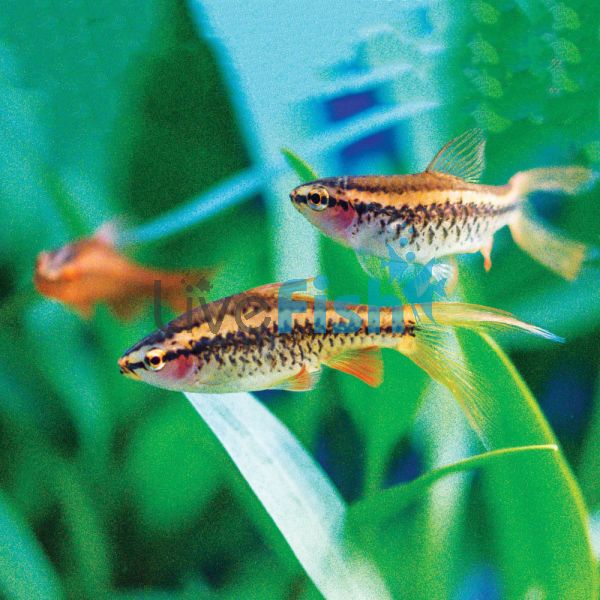Longfin Cherry Barb 3cm
The long-fin cherry barb is the stunning result of captive breeding to enhance an already vibrant and loved fish in the aquarium trade. Through the efforts of line breeding to enhance and bring out desirable traits, the long-fin cherry barb sports unusually longer fins compared to standard cherry barbs. These fish have the colours of a tropical tetra, are extremely hardy, and stay small with long flowing fins that make them look almost mystical in the aquarium.
- Buy 4 for $8.38 each and save 10%
- Buy 8 for $7.45 each and save 20%
Cherry Barb Longfin
The long-fin cherry barb is the stunning result of captive breeding to enhance an already vibrant and loved fish in the aquarium trade. Through the efforts of line breeding to enhance and bring out desirable traits, the long-fin cherry barb sports unusually longer fins compared to standard cherry barbs. These fish have the colours of a tropical tetra, are extremely hardy, and stay small with long flowing fins that make them look almost mystical in the aquarium.
long fin cherry barbs have exactly the same colouration as standard cherry barbs with the only difference being the longer fins. As juveniles, they can look quite washed out which is why aquarists tend to skim over them in stores but once these fish settle in and mature the true beauty of their colours shines. Males develop a metallic blood-red colour from head to tail whereas females have a more orange tiger-style look with brown barring and stripes. With these fish, the long-fin genetics tend to be most isolated towards the tail fin and pectoral fins which is quite interesting compared to other long-fin fish.
Breeding long-fin cherry barbs is quite straightforward as these are captive-produced fish. They are egg scatterers and don't exhibit any parental care. females release their eggs among fine-leafed plants where they're fertilised by the male. The eggs hatch within a few days, and the fry can be fed infusoria or finely crushed flake food. These will also make for a great breeding project for budding fish breeders to try out their experience in egg-scattering fish. Females will be visually different too makes they are also larger in size.
Tank Recommendations for Longfin Cherry Barb
Being a small and relatively easy to care for fish the long-fin cherry barb can be kept in smaller aquariums with the minimum being 75 liters. This aquarium size allows for a decent school of these barbs along with other community fish if required. Long-fin cherry barbs ideally need to be kept in a group of 5 or more to ensure they feel comfortable. These fish won't care too much about hardscape or substrate choices however a lot of bright green plants will contrast the red very well.
Suitable Tank Buddies
Longfin Cherry Barbs are peaceful fish and generally do well with a variety of tankmates. They can also be mixed with normal cherry barbs to create a very dynamic mix of fish however avoiding fin-nipping species will be ideal as they can pester the long-fin cherry barb.
Usually Compatible
Small to medium-sized community fish, other peaceful barbs, tetras, guppies, and bottom dwellers such as corydoras and loaches are good companions.
Sometimes Compatible
Dwarf cichlids and gouramis are sometimes compatible, but care must be taken as they can sometimes be territorial.
Rarely Compatible
Large, aggressive, or predatory species such as oscars, as well as fin-nippers, should be avoided as they can stress, predate, or harm these small and especially long-finned barbs.
Feeding your Longfin Cherry Barb
Longfin cherry barbs are a very easy fish to feed. They will take a wide range of pellets, flakes, and frozen foods. Just like any fish though they should be fed a varied diet with a mix of different foods.
The ideal diet would be a good quality micro slow-sinking pellet or crushed flake, supplemented with frozen bloodworms or black worms or even live foods like baby brine shrimp or micro worms. Providing them with a natural colour-enhancing food that contains astaxanthin will really enhance the colours as well.
| Scientific Name | Puntius titteya |
|---|




